1 Ada Co. Physical Science Building Miocene Epoch
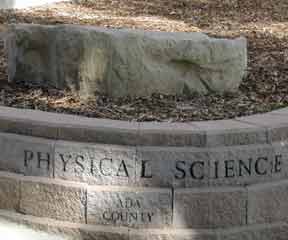 |
| Click here for a close up view |
Tan sandstone from Table Rock Quarry north of Warm Springs Avenue in Boise.
Rock is of late Miocene age, about 10 million years old. It contains feldspar
and muscovite mica grains and was quarried for construction of the Territorial
Prison and other early stone buildings in old Boise.
2 Adams Co. Beckley Nursing Building Cretaceous Period
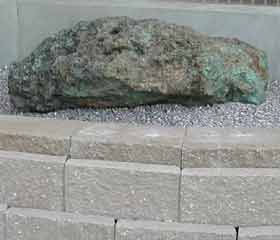 |
| Click here for a close up view |
Brecciated mass of copper ore from the Blue Jacket Mine of the Seven Devils
mining area. Green malachite (copper carbonate) fills fractures. Also present
is encrusting or botryoidal quartz and radiating prisms of epidote.
3 Bannock Co. Administration Building Neoproterozoic Period
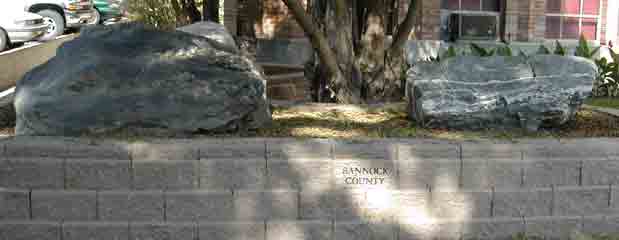 |
| Click here for a close up view of the left Rock and here for the right |
Three rocks from the Portneuf Gap area representing unique elements of the
Bonneville Flood about 14,500 years ago. White boulder of cross-bedded quartz
sandstone was carried through the Gap by the flood. Large maroon sandstone and
conglomerate comes from the Pocatello Formation south of the Gap and contains
cobbles carried in glacial streams about 700 million years ago. Green sandstone
with quartz veins also comes from the Pocatello Formation, but from the north
side of the Gap. This area, below Chinese Peak, was structurally overturned
during mountain building about 100 million years ago. The veins formed at this
time.
4 Bear Lake Co. Public Safety Building Ordovician Period
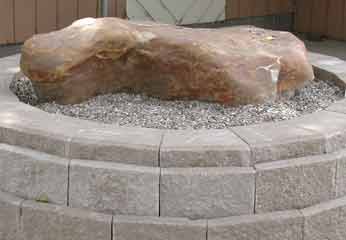 |
| Click here for a close up view |
Cross-bedded sandstone deposited in a storm-washed shallow seaway in Ordovician
time about 490 million years ago. It belongs to the Swan Peak quartzite and
comes from the Bear River Range west of clear blue Bear Lake.
5 Benewah Co. Holt Arena Mesoproterozoic Period
 |
| Click here for a close up view |
Calc-silicate schist with two-inch brown staurolite crystals and tiny wine-red
garnets in the calcareous zones. The rock belongs to the Mesoproterozoic Wallace
Formation and was deposited about 1,400 million years ago. It was metamorphosed
during intrusion of the Idaho Batholith, about 80 million years ago. The rock
was originally a thin-bedded siltstone and impure limestone with tiny convoluted
shrinkage cracks in the silt. This rock has the most spectacular minerals of
the entire Centennial Rock Walk.
6 Bingham Co. Gravely Hall Eocene
Epoch
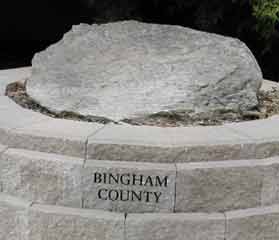 |
| Click here for a close up view |
This unique Eocene volcanic rock, about 45 million years old, is a type of
hornblende andesite, called Shonkonite, and comes from an intrusive sill on
Sugarloaf Mountain in the Caribou Range north of Grays Lake. George Katseanes,
ISU geology major (class of 1950), donated the rock, which was identified initially
by Professor Andrei Isotoff, chair of the Geology Department in the 1940s and
1950s.
7 Blaine Co. College of Engineering
Eocene Epoch
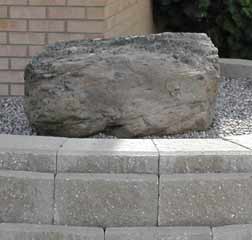 |
| Click here for a close up view |
Fine-grained, platy dacite porphyry lava, part of the Challis Volcanic Group,
that was erupted over much of central Idaho between 50 and 45 million years
ago in Eocene time. The rock comes from the Little Wood River north of Carey.
8 Boise Co. Turner-Garrison Complex Cretaceous Period
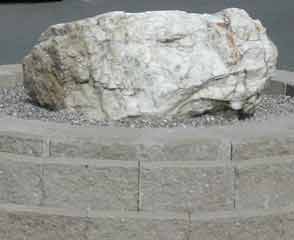 |
| Click here for a close up view |
This white slab of vein quartz with coarse-grained muscovite mica formed in
a shear zone within the Idaho Batholith. Such quartz veins contain gold and
were the mother lode for the huge placer gold workings of the Idaho City area
in the 1880s.
9 Bonner Co. Holt Arena Cretaceous Period
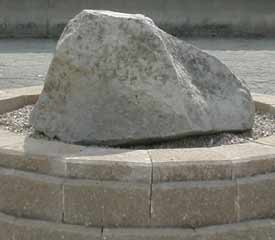 |
| Click here for a close up view |
Light gray fine-grained hornblende-biotite granodiorite, part of the Late Cretaceous
Kaniksu batholith of the Idaho panhandle.
10 Bonneville Co. Hypostyle Pliocene Epoch
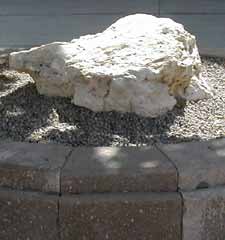 |
| Click here for a close up view |
This layered tan rock is from the Idaho Travertine Mine from Fall Creek in
the Caribou Mountains south of Swan Valley. Hot water traveled along the Grand
Valley fault zone in the last few million years, picked up calcium carbonate
from Paleozoic limestones in the subsurface, and deposited travertine at the
land surface as the water cooled.
11 Boundary Co. Holt Arena Mesoproterozoic Period
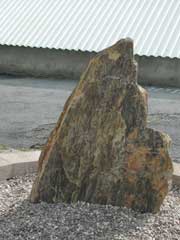 |
This thinly laminated sheared argillite from Boundary County has the crude
shape of the state of Idaho. The rock was deposited in shallow water about 1,400
million years ago and represents Idaho's farthest northern county.
12 Butte Co. Reed Recreation Complex Mesoproterozoic Period
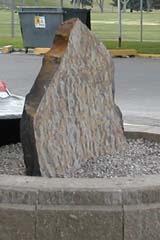 |
| Click here for a close up view |
Thinly laminated micaceous quartzite with pyrolucite (manganese oxide) dendrites
on the flat surface. The rock is from the Belt Supergroup in the southern Lemhi
Range, and was deposited about 1,400 million years ago in Mesoproterozoic time.
13 Camas Co. Vocational Arts Building Pleistocene Epoch
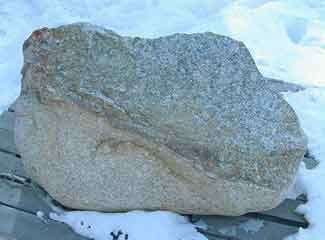 |
Agglutinate from a Pleistocene basalt cinder cone on the Snake River Plain.
Fragmented material was blown into the air and became welded back together upon
hitting the slopes of the eruptive cone.
14 Canyon Co. Colonial Hall Pleistocene Epoch
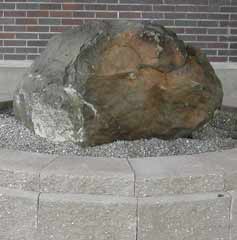 |
| Click here for a close up view |
Rounded bomb of basalt from a Pleistocene cinder cone on the Snake River Plain.
The red staining from interaction with water is evident. Tiny crystals of white
plagioclase and brown pyroxene can be seen upon close inspection.
15 Caribou Co. Plant Services Building Mississippian Period
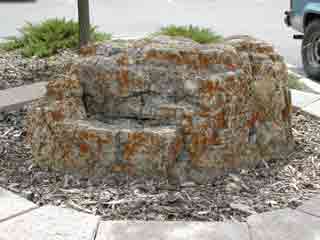 |
| Click here for a close up view |
This limestone comes from Sheep Rock, at the north end of the Bear River Range,
from the Bend in Bear River. Sheep Rock overlooked the Oregon Trail and the
junction with the Hudspeth Cutoff, which headed directly west across Gem Valley
and the Portneuf Range. The rock was deposited about 330 million years ago in
a shallow sea in Mississippian time.
16 Cassia Co. Liberal Arts Building Oligocene Epoch
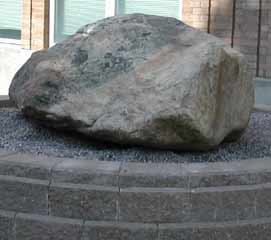 |
| Click here for a close up view |
Huge, water-smoothed boulder of Oligocene granite from the City of Rocks Pluton
from the Albion Range core complex west of Elba. This is the youngest granite
in Idaho, intruded about 30 million years ago.
17 Clark Co. Reed Recreation Complex Miocene Epoch
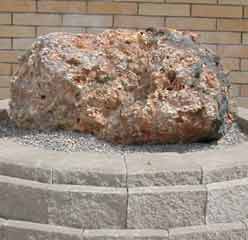 |
| Click here for a close up view |
Spectacular altered Miocene rhyolite from near Spencer. The rock contains baseball-sized
geodes with concentric rings of silica, plus popcorn-sized opal geodes. Dark
rhyolite with white sanidine crystals can be seen in fragments near the base
of the rock.
18 Clearwater Co. Turner-Garrison Complex Cretaceous Period
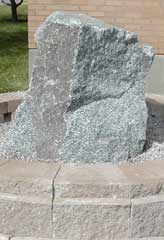 |
| Click here for a close up view |
Salt and pepper foliated tonalite of the Bitterroot Lobe of the Idaho Batholith from the Clearwater Mountains, intruded about 100 million years ago. The white areas are plagioclase feldspar. The black areas contain hornblende and platy biotite.
19 Custer Co. Industrial Crafts Building Eocene Epoch
Eocene Smiley Creek conglomerate from the Pioneer Mountains. Rock contains
pebbles and cobbles of dark argillite and light brown limy sandstone and was
derived from early uplift of the Pioneer core complex about 48 million years
ago.
20 Elmore Co. Physical Sciences Building Pleistocene Epoch
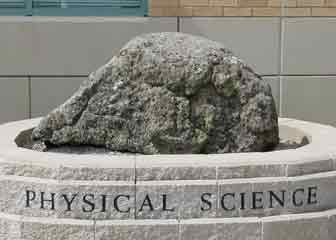 |
| Click here for a close up view |
Boulder of basalt moved a few miles down the Snake River Canyon, from Malad
Gorge to King Hill, by the Bonneville Flood about 14,500 years ago. The basalt
was erupted into the canyon of the Snake River in the last 500,000 years, in
Pleistocene time.
21 Franklin Co. Fine Arts Building Cambrian Period
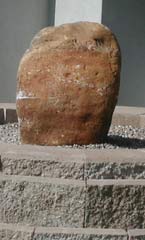 |
| Click here for a close up view |
Boulder of quartzite or tightly cemented sandstone from the shoreline of Lake
Bonneville overlooking Franklin, Idaho's oldest town. Sandstone was deposited
in Cambrian time, about 530 million years ago, and contains trace fossils called
Scolithos, which represent burrows of soft-bodied worms escaping from storms
on a shallow sandy seafloor.
22 Fremont Co. Red Hill Building Pleistocene Epoch
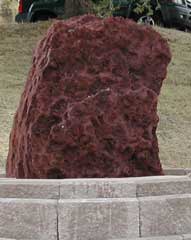 |
| Click here for a close up view |
Deep red agglutinate from a Pleistocene basalt cinder cone, where the lava
interacted with ground water and oxidized the surface of the cinders to red.
The rock contains black basaltic lapilli in a red frothy mass of layered basaltic
glass.
23 Gem Co. Turner-Garrison Complex Miocene Epoch
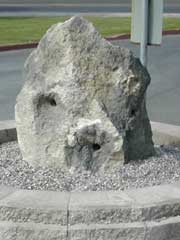 |
| Click here for a close up view |
Crust of a Columbia River Flood basalt lava flow, erupted about 16 million
years ago, in Miocene time. The two drill holes were made when the lava cliff
was quarried for highway construction.
24 Gooding Co. Trade and Technology Building Pleistocene Epoch
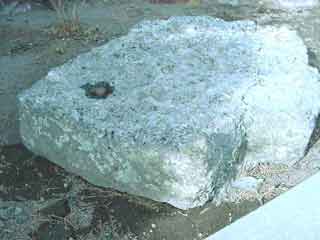 |
Outer crust of a basalt lava flow, part of the late Pleistocene Shoshone Lava
Field, which flowed southward down the canyon of the Big Wood River about 70,000
years ago.
25 Idaho Co. College of Education Miocene Epoch
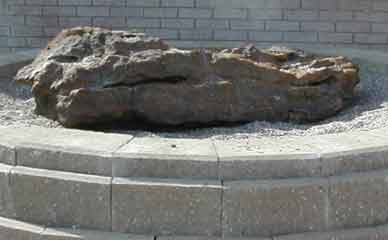 |
| Click here for a close up view |
Deep red coarse-grained Miocene sandstone, deposited by streams flowing off the Idaho Batholith about 10 million years ago. Rock contains pebbles of quartz and feldspar and has been cemented by iron oxide.
26 Jefferson Co. Student Health Center Pleistocene Epoch
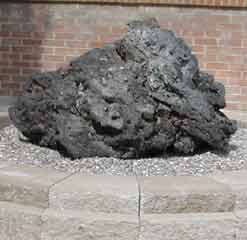 |
| Click here for a close up view |
Agglutinate or welded basaltic spatter rock from a Pleistocene cinder cone
on the Snake River Plain. Basalt lava was flung into the sky and landed on the
flanks of the volcanic cone as molten bombs. These then fused together and flowed
over the sides of the cone.
27 Jerome Co. Eli Oboler Library Miocene Epoch
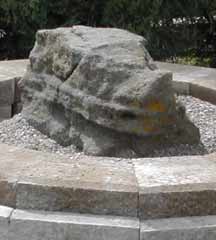 |
| Click here for a close up view |
Banded dark base of a welded rhyolite ash-flow. Rock contains crystals of plagioclase
and a glassy matrix with a concentric perlitic structure. It comes from the
walls of the Snake River Canyon and is from the Miocene Twin Falls volcanic
field, about 10 million years old.
28 Kootenai Co. Holt Arena Mesoproterozoic Period
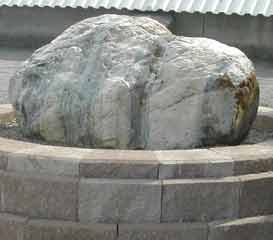 |
| Click here for a close up view |
Hugh boulder of the Wallace Formation carried in the Lake Missoula Flood about
17,000 years ago. The rock contains medium bedded green and white calcareous
siltite and gray impure carbonate, with several sedimentary structures.
29 Latah Co. Holt Arena Mesoproterozoic Period
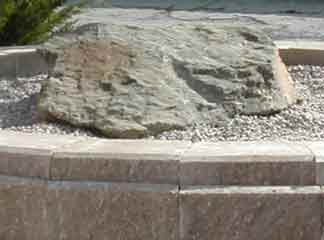 |
| Click here for a close up view |
Garnet schist containing star garnets, the Idaho state gemstone, from the Emerald
Creek district. The rock is metamorphosed argillite and siltite from the Mesoproterozoic
Belt Supergroup and is about 1,400 million years old.
30 Lemhi Co. College of Education Mesoproterozoic Period
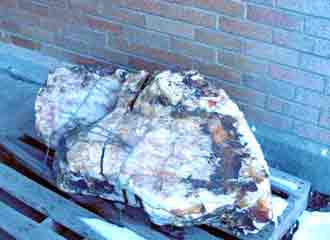 |
Porphyritic potassium feldspar granite from the 1,370 million-year-old pluton
near Shoup along the main Salmon River. The rock has unique rapakivi texture
with concentric growth rings around the blocky orthoclase feldspar crystals.
31 Lewis Co. Speech Pathology Building Miocene Epoch
 |
| Click here for a close up view |
Fine-grained dark basalt with needles of plagioclase feldspar and oxidized
vesicles. The lava was erupted in Washington with the Columbia River basalts
in Miocene time about 16 million years ago and flowed east into Idaho.
32 Lincoln Co. Eli Oboler Library Pliocene Epoch
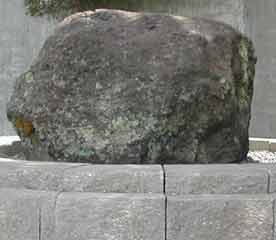 |
| Click here for a close up view |
Unusual red crystal-rich rhyolite from an intrusive volcanic dome in the Pliocene Magic Reservoir volcanic field, formed about 5 million years ago. The rock contains large crystals of quartz and feldspar plus exotic fragments of sandstone and granite fragments ripped from the subvolcanic neck below the dome.
33 Madison Co. Pond Student Union Pleistocene Epoch
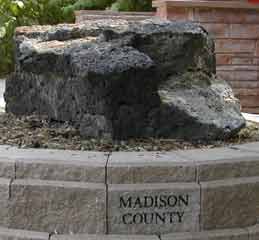 |
| Click here for a close up view |
Basalt lava crust from the chilled margin of a Pleistocene lava flow erupted
on the Snake River Plain less than a million years ago. The spongy interior
of the flow contains vesicles or gas bubbles which represent gas that was dissolved
in the molten lava.
34 Minidoka Co. Eli Oboler Library Pleistocene Epoch
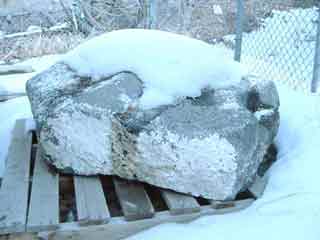 |
Crust of vesicular basalt flow with the shape of a giant three-toed footprint.
The vesicles represent gas bubbles in the lava. The rock is of Pleistocene age,
less than 2 million years, and was erupted as a lava flow on the Snake River
Plain.
35 Nez Perce Co. Lecture Center Miocene Epoch
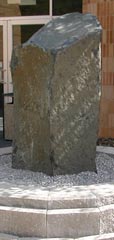 |
| Click here for a close up view |
Spectacular five-sided column of Columbia River Basalt from the colonnade portion
of a lava flow in the Clearwater River canyon. This basalt flowed east from
Washington into Idaho about 16 million years ago. The matrix of the rock is
glassy and contains olivine.
36 Oneida Co. College of Pharmacy Ordovician Period
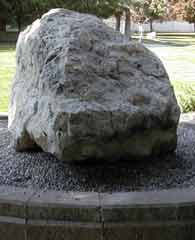 |
| Click here for a close up view |
This, the largest rock in the entire Centennial Rock Walk, comes from the Bannock
Range east of Malad City, just above the Lake Bonneville shoreline. The rock
is Ordovician Swan Peak quartzite, deposited in shallow seafloor about 490 million
years ago.
37 Owyhee Co. Frazier Hall Miocene Epoch
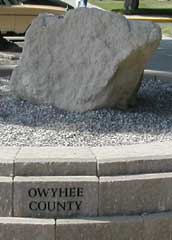 |
| Click here for a close up view |
Distinctive oolite rock from Idaho's largest county is made of rounded coated
grains of calcite deposited on the shore of Lake Idaho about 5 million years
ago. The grains formed from rolling back and forth in sandbars and beaches.
38 Payette Co. Roy F. Christensen Building Miocene Epoch
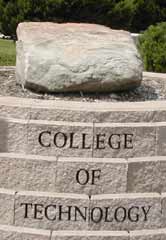 |
| Click here for a close up view |
Coarse-grained sandstone deposited by streams flowing west off the Idaho Batholith
about 10 million years ago. It comes from the Payette Formation and contains
feldspar and quartz grains and crossbeds.
39 Power Co. Dental Arts Building Holocene Epoch
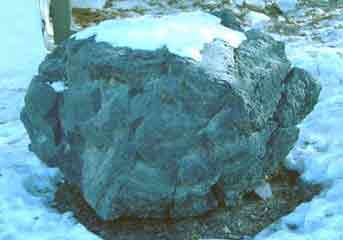 |
Spectacular "bread-crust" volcanic bomb from a 10,000-year-old basalt cinder
cone near Lake Channel north of the Snake River. Rock was donated by David and
Marla Bethke. The cracked crust of the bomb formed as the lava cooled while
falling through the air.
40 Shoshone Co. Plant Sciences Building Neoproterozoic Period
Two-ton specimen of silver ore containing galena and tetrahedrite, from 7,000
feet deep in the Sunshine Mine, which closed in 2001. The sample is thus irreplaceable
and represents the mineral wealth of the Silver Valley along the Coeur d'Alene
River in northern Idaho. Labor unrest in the Silver Valley in the 1890s created
resentment and focused national attention on northern Idaho. Former Gov. Frank
Steunenberg was assassinated by a bomb in Caldwell at Christmas 1905 as a result
of resentment over his sending in Federal troops to quell the labor strife.
41 Teton Co. Early Learning Center Devonian Period
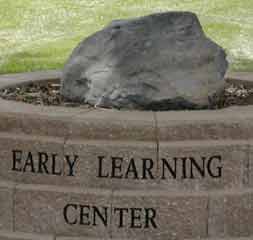 |
| Click here for a close up view |
Dark carbon-rich dolomite, deposited in a shallow sea in Devonian time about
360 million years ago. The rock comes from the west side of the Teton Mountains
east of Driggs. The diffuse layering was formed in very shallow water on a tidal
flat.
42 Twin Falls Co. Business Administration Bldg. Pleistocene Epoch
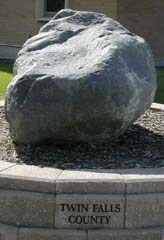 |
| Click here for a close up view |
Boulder of basalt moved a few miles down the Snake River Canyon, from the Blue
Lakes alcove to Kanaka Bar west of Twin Falls, by the Bonneville Flood about
14,500 years ago.
43 Valley Co. Gale Life Science Complex Miocene Epoch
 |
| Click here for a close up view |
Fine-grained dark basalt containing needles of plagioclase feldspar and red-stained
oxidized vesicles (gas bubbles). It is from the Columbia River Basalts and is
about 16 million years old.
44 Washington Co. Gale Life Science Complex Miocene Epoch
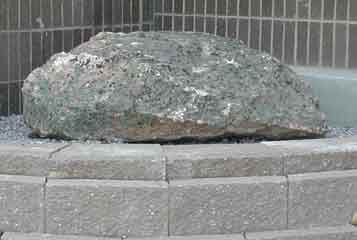 |
| Click here for a close up view |
Unusual altered feldspathic sandstone of the Payette Formation from a mercury mine east of Weiser. The rock has been hydrothermally altered, so that the pink orthoclase feldspar (altered to clay) and clear quartz appear to float in a silicified dark quartz matrix.